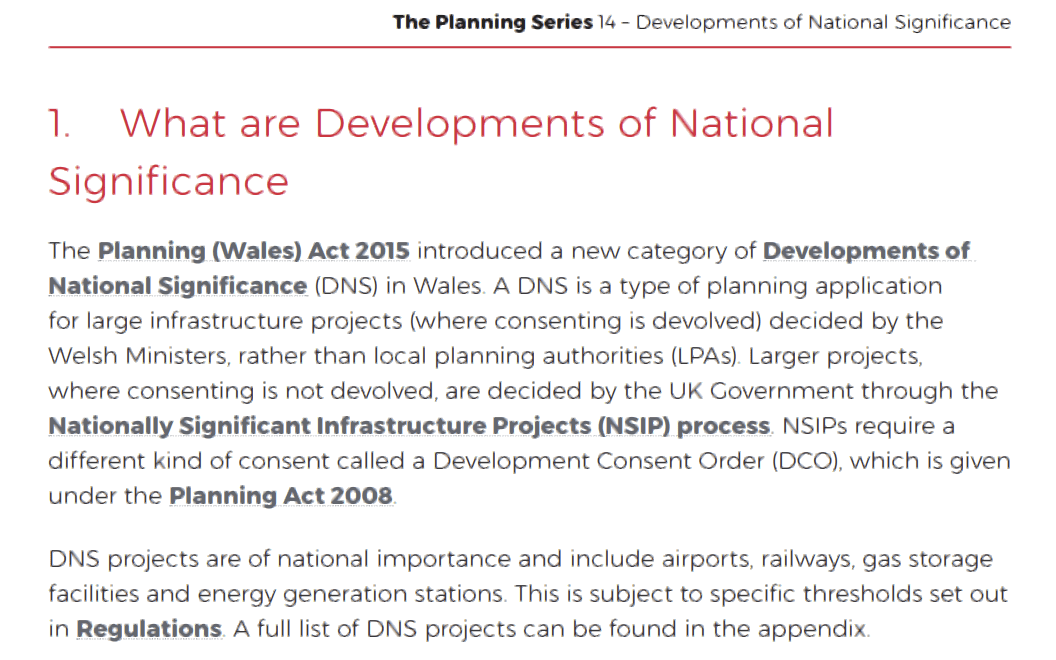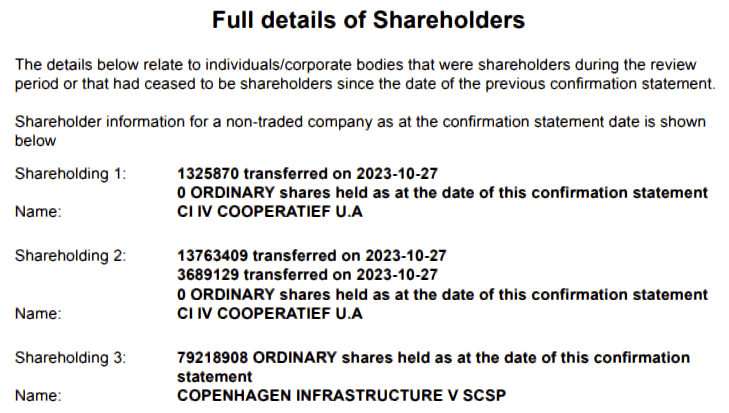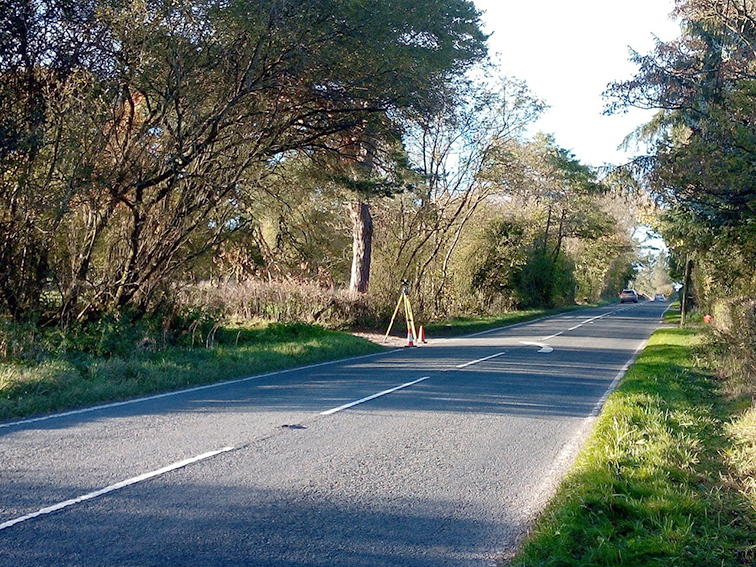![]() I’m returning to the ‘Bute’ stable of companies, a subject I’ve ignored for a while. More especially, some aspects of Bute’s operations that may have been overlooked.
I’m returning to the ‘Bute’ stable of companies, a subject I’ve ignored for a while. More especially, some aspects of Bute’s operations that may have been overlooked.
1/ How did investment company and property developers the Parabola group, from which Bute emerged, learn about the opportunities offered by wind turbines in Wales?
2/ We’ve been told the funding for Bute’s projects will come from Copenhagen Infrastructure Partners and the Wales Pension Partnership. But is that true?
I’m starting with some background, which I think sets the scene. So please indulge me there before we move on later to the ‘meat’ of the piece.
◊
THE TRAILBLAZER GETTING A LITTLE HELP FROM THE COMRADES
Before the boys from Parabola ever heard of Nant Mithil, Waun Hesgog, or Blaencothi, other nobly-intentioned businessmen, alarmed by the impending climate crisis, were trying their damnedest to cover central Wales in wind turbines.
I’m going to focus on one of those wind farms; Hendy, to the east of Llandrindod.
Planning permission was refused by Powys County Council in April 2017, and that decision was upheld by a planning inspector a year later. But then, Lesley Griffiths, Energy, Planning and Rural Affairs Secretary for the self-styled ‘Welsh Government’ intervened, to ignore the inspector’s decision and give Hendy the green light.

Prior to this, an inspector’s decision was almost the final word. But now it was being over-ridden using the legislation that gave us Developments of National Significance.
From now on ‘Welsh Ministers’ had authority to rule on electricity generation projects with a maximum installed capacity of 10MW to 50MW. Below that, responsibility lies with local authorities; and above, it’s the UK government.
Which means that developers pitch their projects in the 10 – 50MW ‘sweet spot’.
The main director of Hendy Wind Farm Ltd was Stephen John Radford. He had other wind companies including, in Wales, Rhoscrowther Wind Farm Ltd, on the Haven, and Bryn Blaen Wind Farm Ltd, near Llangurig.
Radford was very close to, if not fronting for, the U+I group. Though it seemed he also had his own piggy-bank in Njord Energy Ltd.
Lobbying Powys councillors on behalf of the Hendy wind farm was Anna McMorrin. She was seen at a meeting on 27 April 2017, desperately trying to hand a note to councillors considering the project.
She was working for Invicta Public Affairs, which has its headquarters in Newcastle, but also a presence in Edinburgh, and Glasgow.
She had been working as a Spad in Corruption Bay, for which she was rewarded by being selected as the Labour candidate for Cardiff North. In June 2017 she became the MP.
Maybe this is the first instance of someone working simultaneously for the Labour party and wind energy developers. There have been many more since Anna McMorrin.
Once they got to know each other, I’m sure Radford made the boys from Parabola understand that to get anything done in Wales you must have people working for you inside the Labour party.
◊
THEY MEET, AND THE BOYS FROM PARABOLA BECOME BUTE
In September 2018 Windward Generation Ltd was launched; the name changed to Bute Energy the following month, and finally became RSCO 3750 Ltd in March 2020.
The founding directors were Oliver James Millican and Lawson Douglas Steele, who were joined a week later by Radford. The man from Hendy left in December 2019 and was replaced by Stuart Allan George, who’d left Parabola with Millican and Steele.
But I want to go back a little further, and consider the ‘Windward’ name.
Just before Christmas 2014 Windward Enterprises Ltd was launched. This company’s stated business was ‘Financial management’. The sole director was Oliver James Millican, using secretarial services in Edinburgh, but a Newcastle office address for himself. (Newcastle being where Parabola started out.)
This was a long time before any interest was expressed in wind turbines.
In November 2016 the address switched to Broadgate Tower in London, where we now find Parabola; and the company name changed in August 2018 to WELN1 Ltd.
We encounter the ‘Windward’ name a number of times early on in this saga, but what if it has nothing to do with wind power, and instead refers to the Windward Islands in the Caribbean?
I’m thinking now of tax havens. Just a thought.
If you study the timeline of company formations, you’ll see that the first ‘Bute’ company, Windward Global Ltd, wasn’t formed until May 2017. This is now the holding company for the Bute empire, controlled by Oliver James Millican.
Millican’s father, Peter John Millican, runs the Parabola property empire, with more companies under the umbrella than I was able to count. As we’ve seen, son Oliver ceased being a director at Parabola late in 2017.
Steele was employed as Investment Director at Parabola. He left in October 2017.

Stuart George was also a Parabola employee.

And there seems to have been a fourth departure. For on 31 May 2018, in addition to Windward LS Ltd (Lawson Steele), and Windward SG Ltd (Stuart George), a company called Windward BW Ltd was launched.
The ‘BW’ is Barry Woods. I can’t tell you much about him, except that he’s Irish, and he’d also worked for Parabola. In fact, he was a designated partner, along with Parabola Real Estate Investment Management LLP, in Parabola Partners LLP.
Just like Millican, Steele and George, Woods quit Parabola in November 2017.
He then seems to have parted company with the other three on 24 September 2019. The last trace of Woods sees him running Woods Investment Management Ltd in Edinburgh, which folded after a couple of years, in March 2021.
So we have four men, all in their thirties, and all working for a major property and investment group (one of them the boss’s son); but late in 2017 they apparently hear the planet calling, sever their ties with Parabola, and go off to erect wind turbines in Wales.
Do you buy that?
Something else that gives off a bit of a whiff is that if the four of them had started up on their own, I would have expected to see them as partners. But Millican Junior in control suggests a continuing link with his father’s business empire.
Using the Parabola address at the Broadgate Tower, 20 Primrose Street, London EC2A 2EW is also a bit iffy.
It’s far more likely that, in 2017, the four turbineers started setting up companies in Wales, ultimately owned and controlled by Parabola, to capitalise on the ‘How many turbines would you like, duckie?’ DNS system.
◊
MONEY, MONEY, MONEY
Funding is a vital consideration because more than 20 wind farms, an unknown number of solar arrays, at least 6 Battery Energy Storage System (BESS), and mile after mile of pylons, requiring connectors and other whatsits, do not come cheap.
Admittedly, nothing has yet been built, but even so, Bute employs dozens of people, rents or leases office space, and promotes itself relentlessly by sponsoring everything from the Ystradgynlais Wet T-shirt Olympics to the Llanfair Caereinion Refuge for Distressed Ferrets.
So where’s the money coming from to fund this unrivalled extravaganza of bird dicing?
We can (perhaps surprisingly) rule out the Development Bank of Wales, a soft touch that throws moolah at magic bean salesmen and landfill-owning friends of politicians.
Instead, our attention must turn to the two stated funding sources: Copenhagen Infrastructure Partners (CIP), and the local councils’ Wales Pension Partnership (WPP).
The WPP involvement is a bit of nonsense that it’s hoped will give the impression Wales is benefitting from wind power. Though on a more practical and political level I suppose it gives Bute even more leverage in Corruption Bay.
I’m going to focus on Copenhagen Infrastructure Partners and see where that takes us.
Now the first thing to make clear is that CIP is not a bank, it does not provide funding. The clue appears to be in ‘Partners’, for it seems investors looking for green projects go to CIP, which then finds them the right fit.
Or it could be t’other way around. Either way, we can be sure CIP takes its cut.
The funding from CIP for Bute is channelled through CI IV Dragon Lender Ltd. This is owned by CI IV Dragon Holdco Ltd. Both companies are based in Rotherham, South Yorkshire.
The latest accounts for CI IV Dragon Holdco (y/e 31.12.2022) give a list of ‘Subsidiary undertakings’ (page 20) in which the company holds a ‘golden share’. These are Bute companies, including Green Generation Energy Networks Cymru Ltd, which wants to build a network of pylons.

And as you can see below, since October last year all 79,000,000 shares in the holding company are in the possession of Copenhagen Infrastructure V SCSp.

Which can be found at 16 Rue Eugene Ruppert, L2453, Luxembourg, the EU’s internal tax haven.

And at that address we find an outfit called Vistra. So who are they? It turns out they’re a Fortune 500 company from the Lone Star State. Well, Ye haw!
Vistra is big itself in electricity production and supply, but it also ‘partners with suppliers’, which would presumably include Bute.

But why is Bute dealing with Copenhagen Investment Partners which is dealing with a US company working out of an office in Luxembourg? Especially when Vistra has offices in the UK.
Among them, a very familiar address in Edinburgh. In fact, if you close in on this Google maps capture you’ll see the Vistra plate, top right.

The name Vistra was vaguely familiar, but not in connection with Bute. It was linked more with the Bristol address you see above, and Galileo, which wants a wind farm at Bryn Cadwgan, to the east of Lampeter.
All explained in this piece from last November, A Change Of Tack?
Galileo is based in Zurich, Switzerland. It began life locally at Vistra’s Bristol office before moving to Edinburgh. But there’s also Galileo Empower Wales Ltd which has a presence on Cathedral Road in Cardiff.
Its directors are Italian, German, Scottish and Irish. A typical ‘Welsh’ company.
The Bute companies are fronting for Vistra of Texas through Copenhagen Infrastructure Partners. The ‘golden share’ in so many Bute companies means that those projects are effectively owned by Vistra.
With an obvious connection via Oliver Millican to his father’s Parabola group. Which we must assume is also getting a cut.
The sequence would appear to be: Parabola spawns Bute, Bute goes to CIP, CIP finds Vistra, and Vistra either puts in its own money, or it finds funding from . . .
UPDATE 30.04.2024: A reliable source draws my attention to another link between Copenhagen and Vistra. There are many more.
UPDATE 2: 30.04.2024: Another source reminded me there are many Njord companies. Often linked to CIP. A little digging brought up yet another, and an intriguing connection.
Copenhagen Offshore Partners A/S has an office at 10 George Street, Edinburgh. At the same address we find Rathbone Investment Management (£60bn assets). A member of the Rathbone family is Jenny Rathbone MS, who sits on the Climate Change Committee.
Her Partner, John Uden, was recruited (for no obvious reason) to sit on Bute’s Welsh Advisory Board.
I think we’re at the stage now where so many Labour people (some I’ve never mentioned) are benefitting financially from Bute / CIP that an independent inquiry is needed.
◊
CONCLUSION
The situation is that through Developments of National Significance, and now the Infrastructure Bill, Wales is being desecrated and exploited by foreign corporations.
The ferrets of Llanfair Caereinion notwithstanding, there are no real benefits for us; nothing in terms of jobs, or anything else.
The real beneficiary is England, where communities can and do object to wind farms. Which is why, as reliable sources of electricity generation are phased out on the orders of Globalist ‘environmentalists’, electricity generated in Wales must go to England, and this explains the need for so many pylons.
The wind farms, solar arrays and pylons in Wales (and Scotland), are also needed to help the UK / England meet its Net Zero commitments. Which I suppose raises the possibility of political pressure being applied from London.
What’s happening is so obvious that I even find myself in agreement with the leftist(s) who wrote, ‘Neoliberalism Has Quietly Flourished Under Welsh Labour – It’s Time To Break The Silence‘. (The comrades love slick and catchy titles!)
Joking aside, and looming over all other considerations, my biggest worry is that even though we can now identify Bute, and Parabola, and CIP, and Vistra, we still can’t be sure where the money for these projects begins its journey.
Which provides two major headaches.
If the Bute funding needs to be ‘filtered’ so many times (with everybody taking a slice) then it raises suspicions that the original funder may not be entirely acceptable.
And if we don’t know who ultimately owns the installations, then how do we get these sites restored when they come to the end of their working lives?
Instead of being suckered by those fronting these projects those pretending to run this country need to establish who is ultimately funding each and every project operating in Wales or proposed for Wales.
We also need to look into the relationship between Bute Energy / Parabola / CIP / Vistra and the ‘Welsh Government’. In particular, how it’s grown to the point where Bute has a position close to being a state-sponsored monopoly.
♦ end ♦
© Royston Jones 2024









